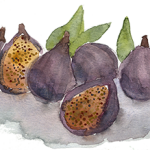Award Winning Author
Face Reading with Before & After Photos
Figs
Part of the fun of biting into a fig is crunching into its hundreds of pinpoint-sized seeds. The fig’s intense sweetness is yet another pleasure. But it’s all those seeds—there can be as many as 750—that explain a fig’s curious biology.
Each seed comes from an individual blossom hidden within the fig itself. These unseen flowers mature into seeds. And then, as the fig dries and its moisture wicks out, the seeds shrink into minuscule, pinpoint sized seeds that make satisfying pops as you bite into them.
Figs are one of humankind’s oldest cultivated crops and one of my favorite treats—either fresh or dried. When fresh, these elegantly shaped fruits are best eaten ripe off the tree. Once picked figs won’t get sweeter. But they quickly soften and this makes them highly perishable. As a consequence, about 90% of the world’s fig harvest is sold dried.
Local fresh figs are now available in select area markets and the Grower’s Markets. Look for plump, soft but resilient fruits with sheen on their blossom end which indicates ripeness—and therefore more flavor and sugar. There are several varieties available—each with their own flavor characteristics, and each, utterly delicious if it was ripe when picked.
A common dried fig is the tan colored and slightly nutty-flavored calimyrna. Another is the sweeter and almost black mission fig. Dried figs should have an almost musky aroma and be slightly moist.
Of all common fruits, dried figs have the highest overall mineral content—they’re high in iron and ounce for ounce they’re higher in calcium than cow’s milk. Figs have even more fiber than prunes. Because figs have edible seeds, they’re one of the few fruits that contain the valuable omega-3 and omega-6 essential fatty acids. Figs also contain from 4 to 50 times more bioflavonoid antioxidants than do other fruits.
Historically figs are renowned for building energy and for supporting digestive function and bowel regularity.
Purchase dried figs without sulfite or potassium sorbate preservatives. Pound for pound, preservative-free figs give you more fruit for your money because the preservatives enable the fruit to retain up to 30% more water.
Natural, additive-free figs are darker in color; because they contain less water, their flavor and nutrients are more concentrated and they’re chewier. All dried fruits are concentrated. Six pounds of fresh figs, for example, yield one pound dried.
Store dried figs in an airtight container and at a low temperature. There are best used within a year of purchase. Sometimes a powdery bloom forms on dried figs; this is the fruit’s natural sugar in a crystalline form and it is edible.
If, however, it’s a fresh fig that’s in your hand, eat it on the spot. But eat it slowly to fully savor its lush and varied textures. My favorite way to cook fresh figs is to cut them in half, splash with liqueur and then either grill or broil them just until their tops get bubbly and caramelize. Serve hot.
See accompanying recipes for Fig Compote
May you be well nourished,
Rebecca Wood


I have 2 fig trees and I wish my yard was bigger so I could plant more. Right now they are only about 3 feet tall and oh my goodness they’re filled with figs.They all don’t ripe at same time. Boy, I look forward to them.
I fully agree, there’s possibly no fruit more sensual than a tree-ripened fig. Enjoy!
Thank you for this post.
Should figs be peeled before eaten?
Fig skin is edible and a good source of fiber.